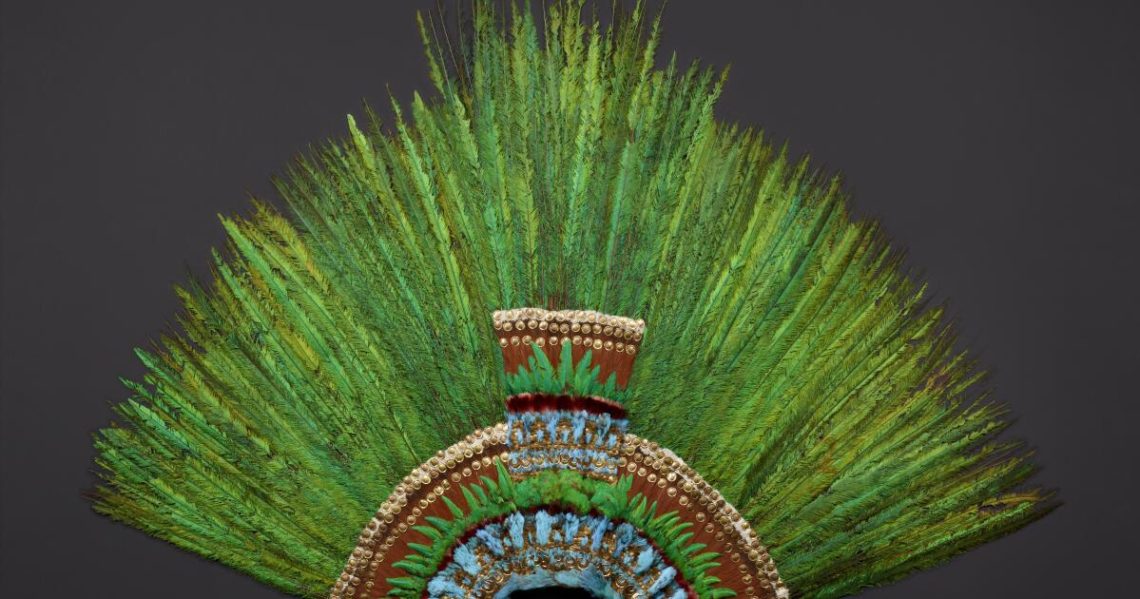VIENNA — On their 30th wedding anniversary, the couple from Mexico were determined to fulfill a long-deferred aspiration: a visit to this storied former Hapsburg capital. And they didn’t come just to catch an opera and savor the Sachertorte.
“We always wanted to see el penacho de Moctezuma,” said Gema Vargas, referring to the feathered headdress widely attributed to the legendary Aztec emperor. “It’s much more beautiful than we imagined.”
But, she added: “It should be in Mexico.”
For more than a century, Mexican officials have called the penacho a cultural touchstone and sought its return from Austria — despite no evidence that Moctezuma actually wore it. Austrian officials insist the brittle object is too delicate to move from its perch in Vienna’s renowned Weltmuseum.
Despite its lore and beauty, the penacho suffers from a case of contested identity: In Austria, it is a treasured possession of the state. In Mexico, it remains a marker of national identity.
“One has to think of el penacho in two different ways,” said Miruna Achim, professor at the Autonomous Metropolitan University in Mexico City. “It’s a historical artifact. But it’s also a symbol — a highly politicized symbol.”
From its display case in the museum’s “Stories from Mesoamerica” hall, the iridescent plumage shimmers like a rainbow encased in glass, a tropical interloper to these northern climes.
The museum gift shop does a brisk sale in penacho-themed books, postcards, pillboxes, scarves and the like.
The penacho’s formal title — “Quetzal Feather Headdress” — understates the grandeur of a one-of-a-kind piece with a back story stretching back more than half a millennium.
Visitors record Instagram moments in front of the almost 6-by-4-foot palette of dazzling hues — the product of hundreds of feathers from the long-tailed quetzal bird, interwoven with plumes from other species and gold ornaments. The anonymous artisans painstakingly sewed the feathers onto a net grid, stabilized with thin wooden rods.
The intricate ensemble, weighing in at less than 4 pounds, somehow survived the Spanish conquest, a perilous ocean crossing and two centuries of musty anonymity in a Tirolean castle.
The penacho, experts say, probably dates from the early 16th century, about the time when much of current-day Spain became part of the Hapsburg empire. But there is no record of who made it and, above all, how and when it ended up in Austria.
Its first recorded mention, according to an authorized history, appears in a 1596 inventory of the “Chamber of Art and Wonders” of Archduke Ferdinand at the Ambras Castle in Innsbruck. The ledger notes “a Moorish hat of long, beautiful, gleaming, shining greenish and golden feathers … decorated with golden rosettes and discs, [and] on the forehead a solid gold beak.”
Later appraisals adduced that the enigmatic piece was an apron, a garment or a military banner, before analysts in 20th century Vienna agreed: It was a headdress. By then, however, the golden beak had long vanished and its original, three-dimensional shape had folded into its current fan-like form.
The penacho, experts say, was likely among the Mexican booty that the conquering Spanish dispatched back across the Atlantic. It was an era when “curiosities” from the newly “discovered” Americas transfixed Europe. The splendor of the pieces stunned even worldly observers like Albrecht Durer, the Renaissance master.
In his 2021 book, “Conquistadores: A New History of Spanish Discovery and Conquest,” Fernando Cervantes, a British-based Mexican historian, cites Durer’s 1520 journal entry after viewing a treasure horde dispatched to Carlos V from Hernán Cortés. The Spaniard’s forces would overthrow Tenochtitlán, capital of the Moctezuma’s Aztec empire.
“All the days of my life I have seen nothing that rejoiced my heart so much as these things,” the German artist wrote of Cortés’ plunder. “For I saw among them wonderful works of art, and I marveled at the subtle Ingenia of men in foreign lands.”
To this day, Cortés and Moctezuma remain figures of both adulation and disdain, recalled in operas, plays, books and films and TV series.
With the passage of centuries, the Eurocentric accounts that depicted Cortés as a heroic “white savior” and Moctezuma as a cowardly heathen have been eclipsed. These days, Mexican leaders and many others label Cortés as barbarous — even genocidal — while Moctezuma often gets a pass as a righteous leader caught in the headwinds of history.
Ultimately, it was Cortés’ ruthlessness — his forces took Moctezuma prisoner and held him as a hostage — that helped doom Tenochtitlán. Moctezuma died in custody under circumstances that remain disputed.
“There’s no question that Cortés played his cards very well,” said Cervantes, an associate professor at the University of Bristol in England. “He knew nobody was going to do anything to him if it wasn’t ordered by Moctezuma.”
In the Mesoamerican world, feather work was highly esteemed, not only adorning headpieces but also clothing, weapons and other accessories typically associated with rulers, gods and warriors. Certain feathers, it is said, had more value than gold.
Of special demand was the glittering plumage of the quetzal, a lustrous creature native to southern Mexico and Central America. This denizen of the cloud forests shares pedigree with a fabled deity: Quetzalcoatl, the “Feathered Serpent.”
Today, the penacho on display in Vienna is the only surviving feathered headdress among the multitudes that once proliferated in the region.
For many of the growing number of Mexican visitors to the Weltmuseum — more than 25,000 have come this year, a record — viewing the penacho becomes something of a spiritual experience. It is much more profound, many say, than seeing the replica at the National Anthropological Museum in Mexico City.
“To stand in front of an object that carries such historical significance made me feel a profound connection to my roots,” said Samantha Lara, 31, a Mexican physiotherapist who was visiting with her family. “It was a reminder of the grandeur of our culture and the pride of being Mexican.”
The allure of the penacho has long resonated among Mexico’s political elite. Some launched quixotic campaigns to get it.
The first was none other than Maximilian, the ill-fated Hapsburg royal, who, with French military backing, was installed as “emperor” of Mexico in 1864. In Maximilian’s view, the penacho “would have afforded him the badges of rulership and presented him as an heir to the Aztec emperors in the eyes of his subjects,” Achim wrote in West 86th, a cultural journal.
But Maximilian’s older sibling, Franz Joseph I, the Austrian emperor, balked at relinquishing the headdress.
Ultimately, Maximilian never shed the stigma of being a foreign interloper. In 1867, as Paris withdrew support and Washington backed the nationalist cause, Maximilian drew his final breath before a Mexican firing squad.
Taking up the penacho cause in the 21st century was former President Andrés Manuel López Obrador, an avid amateur historian.
The then-president dispatched his wife — an academic of German ancestry — to Vienna on what he acknowledged was a “mission impossible”: to persuade Austria’s leaders to lend the headdress to Mexico for a one-year exhibition in 2021 marking the 500th anniversary of the fall of Tenochtitlán.
In return, Mexico offered to ship to Austria various objects from Maximilian’s ill-fated reign, including a gilded carriage in which he and his wife, Carlota, tooled around the capital.
Predictably, Vienna said no. The Mexican leader lashed out at his Austrian counterpart as being “arrogant” and “bossy.” López Obrador’s successor, President Claudia Sheinbaum, has also called for the return of the penacho, but in low-key fashion.
The protracted controversy about where the headdress belongs highlights a global debate about cultural appropriation. Curators in Europe and the United States face pressures to repatriate items to Latin America, Africa and elsewhere. Many illustrious institutions, among them the Getty in Los Angeles, have returned works acquired under questionable circumstances.
“We are not against restitution,” Claudia Banz, director of Vienna’s Weltmuseum, said in an interview. “We have to face the fact that big parts of collections of ethnological museums have been, let’s say, looted. … But, on the other hand, restitution is really complex. … It’s not just about giving the objects back and then it’s done.”
In 2012, a commission of Austrian and Mexican experts completed an extensive restoration of the heavily damaged penacho, ravaged by time, insect depredation and other factors. The binational brain trust’s conclusion? El penacho was too fragile to be moved.
Mexican activists accuse Austria of concealing its real motive — profit — and note that the penacho is among the Weltmuseum’s most popular attractions. Critics demand that Mexican lawmakers be more proactive in pushing for the return of the “crown” — the title promoted by Xokonoschtletl Gómora, a septuagenarian Mexican dancer, author and lecturer who has long been the face of the bring-back-el-penacho movement.
“The crown gives a huge amount of prestige to the museum, draws a lot of visitors and makes a lot of money,” said the indefatigable Gómora, who has spent more than 40 years organizing penacho rallies in Austria and Mexico. “Saying it can’t be transported is just an excuse. If mummies from ancient Egypt can be moved across continents, why not this?”
Gómora’s passion has inspired a new generation of penacho militants. In 2022, a group of activists — including Mexicans and Europeans — hacked the Weltmuseum’s hand-held audio guides and inserted a fiery harangue from Gómora.
“For the Europeans, el penacho is beautiful, ancient and, principally, exotic,” Gómora’s recorded message informed museum-goers, in a stark departure from anodyne guide-speak. “But for us, the Aztecs, this crown carries the force, power and knowledge of the sovereign Moctezuma. … It means a lot more than history narrated by an invader.”
Among the hack’s organizers was Sebastián Arrechedera, a Venezuelan Mexican filmmaker who has produced and directed a documentary about the hack episode. Organizers are planning a Dec. 12 opening in Los Angeles before the film hits the festival circuit.
The penacho, said Arrechedera, “has a certain magic, an energy, a vibe that you can feel.”
Last month, Gómora and allies returned to the Weltmuseum, this time to unveil a high-tech container crafted by a German vibration engineer. The crate can safely transport the headdress, the activists asserted.
Museum authorities dismissed the container design as flawed.
“It’s a difficult and complex matter — and, above all, an ethical one,” said Banz, the Weltmuseum director. “It requires a political resolution.”
That could be a long time coming, even as visitors continue to wonder at the resplendent feathered headdress, a marvel from an era shrouded in the mists of time.
Times special correspondents Liliana Nieto del Rio in Vienna and Cecilia Sanchez Vidal in Mexico City contributed to this report.
The post Vienna’s treasure, Mexico’s wound: The fight over ‘Moctezuma’s headdress’ appeared first on Los Angeles Times.




